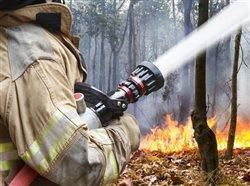California Assembly Speaker Robert Rivas this week announced millions of dollars in new Cal Fire grant funding for programs including the San Benito Fire Safe Council that plan and implement wildfire prevention efforts.
The San Benito Fire Safe Council and Community Foundation for San Benito will receive $168,984 from the total allotment of about $2.6 million in state grant funds for Central Coast communities announced by Rivas’ office. Other Central Coast organizations receiving funds include the Monterey County Regional Fire District, Fire Safe Santa Cruz County, the City of Greenfield and Santa Lucia Preserve.
The grant funds are part of an effort to help prevent wildfires from destroying communities, families, homes and businesses, Rivas said.
“Our Central Coast is all too familiar with devastating and destructive wildfires, and this grant funding is critical to organizations committed to prevention, mitigation and keeping our region safe, especially our vulnerable communities,” said Rivas, who represents communities across San Benito, Santa Cruz, Monterey and Santa Clara counties.
Last week, the wildfire prevention grant program announced $90 million in total funding for 94 wildfire prevention projects across California, says the press release. More than two-thirds of the projects were allocated to communities that are low-income or disadvantaged. The funding aims to improve public health outcomes and safety by helping reduce greenhouse gas emissions, hazardous fuels, and prevent wildfires through planning and education.
The San Benito Fire Safe Council and Community Foundation for San Benito County were first-time grantees. The funding will help ensure they continue wildfire prevention and education programs and projects in the San Juan Canyon and Aromas region of the district, said Rivas’ office.
“We are very excited to receive this much-needed grant money that will help us keep our homes, roads and communities safer,” said Liz Chandler, Firewise Community Coordinator for the San Benito Fire Safe Council. “There are many people living in our smaller communities within the district who take time out of their busy schedules to make their neighborhoods more resilient to wildfire: from educating and promoting home hardening/defensible space best practices to clearing dead trees and flammable fuels from critical roadways.”
Chandler continued, “When we come together to do this work, it makes all of us safer. We appreciate the state recognizing our efforts and helping us take it to the next level.
“By preparing our roadways and properties, we aren’t just making it safer for residents and first responders. By doing this work, we are making it easier for firefighters to do their jobs with the best chance of a good outcome, should a fire occur.”
The Monterey County Regional Fire District, which works closely with the City of Salinas to provide fire and emergency medical services and responds to structure, wildland, vehicle and other types of forest that occur in the district, will receive about $1.1 million for a Community Hazardous Fuels Reduction project.
“Projects and efforts will be focused on fire apparatus access, roadside clearance for emergency egress, assistance in creating improved defensible space for elderly and disadvantaged residents, funding a district-wide multi-year chipping program, and providing resources for clearing and thinning of vegetation within our Firewise communities,” said David Sargenti, Fire Chief for Monterey County Regional Fire District. “
Also receiving funding in the Central Coast are Fire Safe Santa Cruz County (about $1 million), Santa Lucia Preserve ($196,431) and the City of Greenfield ($189,263).
Over the past five years, the Cal Fire wildfire prevention program has funded over 450 wildfire resilience projects that focus on increasing the protection of people, structures, communities and the environment, Rivas’ office said. The program furthers California’s Wildfire and Forest Resilience Action Plan that is funded in part through California Climate Investments which put cap-and-trade dollars to work.










